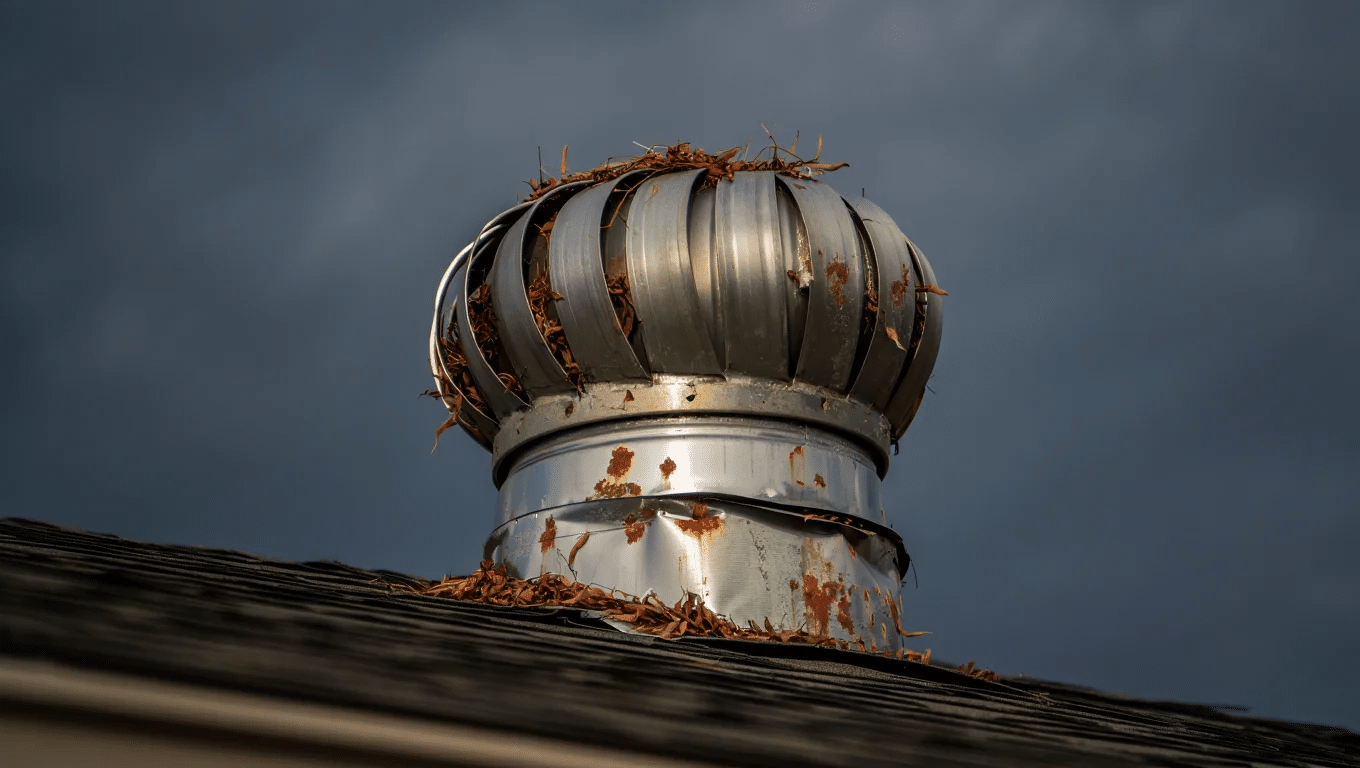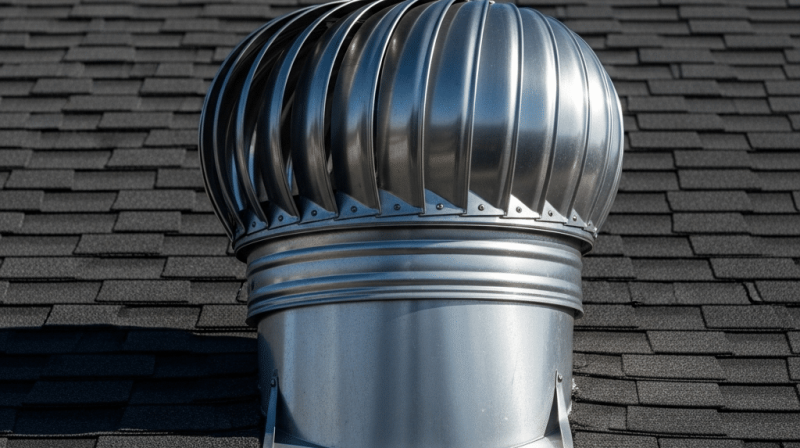I love how turbine roof vents work. They spin quietly on your roof, pulling hot air from your attic and keeping energy bills low.
Plus, they help your roof last longer by preventing moisture buildup. But here’s the thing: when these vents develop problems, all those benefits disappear fast.
I’m going to show you exactly how to spot and prevent the most common turbine roof vent issues before they drain your wallet.
By the end, you’ll have the knowledge to keep your vents running smoothly year-round.
How to Spot a Problem with Your Turbine Roof Vents
I always tell homeowners that catching turbine vent problems early can save hundreds in repair costs. Your senses are your best tools here, and I’ll show you exactly what to look and listen for.
1. Visual and structural warning signs – Look for vents that wobble, sit crooked, or have rust stains running down. Check for loose screws, gaps around the base, warped flashing, or cracked sealant that lets water seep in.
2. Sound problems during operation – Listen for rattling, grinding, or squeaking noises on windy days. Healthy turbine vents should spin quietly. Loud or unusual sounds mean bearings need attention or replacement soon.
3. Poor performance indicators – Check attic temperature on hot days – if it feels much hotter than usual, vents aren’t working. Musty or stale odors also signal poor air circulation from faulty vents.
4. Weather and debris damage – After storms, inspect for bent components, debris stuck in fins, or ice buildup that can warp metal or jam the spinning mechanism.
Turbine Roof Vents: Problems, Causes and Solutions

Through years of home maintenance, I’ve seen these common turbine roof vent problems cause serious issues:
1. Rusting or Corrosion
Rust appears around the base or spinning components, especially in coastal or humid environments. Over time, this weakens the vent’s integrity and may lead to collapse during severe weather.
- Cause: Salt air, high moisture, and aging materials
- Effect: Structural weakening; potential collapse during storms
- Prevention: Apply rust-resistant coatings and inspect regularly for early signs
2. Noisy or Stuck Vents
You may hear grinding, squealing, or notice that the vent doesn’t spin. These sounds signal mechanical issues that reduce or stop airflow, leading to attic overheating and moisture buildup.
- Cause: Failed bearings, lack of lubrication, or debris obstruction
- Effect: Ventilation failure; increased attic temperatures and humidity
- Prevention: Lubricate moving parts and clear debris seasonally
3. Poor Airflow or Blockage
Clogs like leaves or nests around the vent opening or stuck internal flaps can choke airflow, turning your vent into a decorative object instead of a functional ventilation tool.
- Cause: External blockages, ice dams, or broken internal parts
- Effect: Hot, humid attic; potential for mold and wood rot
- Prevention: Clear surrounding debris and inspect dampers monthly
4. Improper Installation
Vents may be installed too close, poorly sealed, or mismatched in size, which not only reduces efficiency but may also lead to leaks and long-term mold problems inside the attic.
- Cause: Inexperienced installers or cutting corners during setup
- Effect: Water intrusion, mold formation, and poor ventilation
- Prevention: Hire licensed professionals and follow manufacturer guidelines
5. Bearing Failure
If the vent spins unevenly, wobbles, or stops entirely, worn-out bearings are likely to blame. This compromises the system, increasing strain on your roof and reducing energy efficiency.
- Cause: Exposure to weather and lack of maintenance
- Effect: Vent stops working; possible roof damage or noise issues
- Prevention: Replace bearings as needed and shield the vent from extreme exposure
6. Wind Damage
High winds can bend fins, crack the housing, or even blow the vent off the roof, leaving your attic unprotected and the roof open to leaks and further damage.
- Cause: Storm pressure or extreme gusts
- Effect: Vent dislodgment, roof breaches, and internal water damage
- Prevention: Secure vents with storm-rated fasteners and inspect after storms
DIY vs. Professional Installation: What’s Better?
I see many homeowners attempt turbine vent installation to save money, but several risks make this challenging. Improper sealing around the base causes water leaks that damage ceilings and insulation.
Here’s a comparison of DIY installation vs. professional installation to provide a better understanding of both options.
| Aspect | DIY Installation | Professional Installation |
|---|---|---|
| Cost | Lower upfront cost | Higher initial expense |
| Skill Required | Basic tools, but risk of errors | Expert knowledge and precision |
| Common Risks | Improper sealing, poor placement | Minimal if done by a licensed installer |
| Time Involved | Can be time-consuming | Quick and efficient |
| Long-Term Reliability | May need fixes or rework | More durable and code-compliant |
| Warranty/Support | Usually none | Often includes warranty and service guarantee |
When to Call Professionals?
Steep roofs, multi-story homes, or complex roof structures require professional expertise.
First-time installations need proper technique to avoid costly mistakes. If you’re unsure about any aspect of the job, professional installation protects your home and your safety.
Tips for Maximum Lifespan
Choosing the right materials, ensuring balanced airflow, and strategic maintenance can make all the difference in performance and longevity.
Here are some expert tips to optimize your attic ventilation system:
- Choose stainless steel vents in coastal areas for salt resistance. Use aluminum in moderate climates. Pick heavy-gauge galvanized steel for harsh winter regions with ice.
- Test attic ventilation by measuring temperature difference from outside air. Properly ventilated attics stay within 10-15 degrees of outside temperature on hot days.
- Install one turbine vent per 150 square feet of attic space. Add passive ridge or soffit vents for air intake to create balanced circulation patterns.
- Position turbines on the roof side that catches prevailing winds. This simple placement increases spinning performance by up to 30% year-round in most areas.
- Service vents right after winter but before summer heat peaks. Spring maintenance ensures peak performance during high-demand cooling season when savings matter most.
Conclusion
Now you know exactly how to protect your turbine roof vents from costly problems.
I’ve shown you the warning signs to watch for, from visual clues like rust and wobbling to performance issues like poor airflow. More importantly, you have a clear prevention plan that works.
Regular inspections and basic upkeep prevent small issues from becoming major headaches. If you spot any issues, address them now before they worsen.







